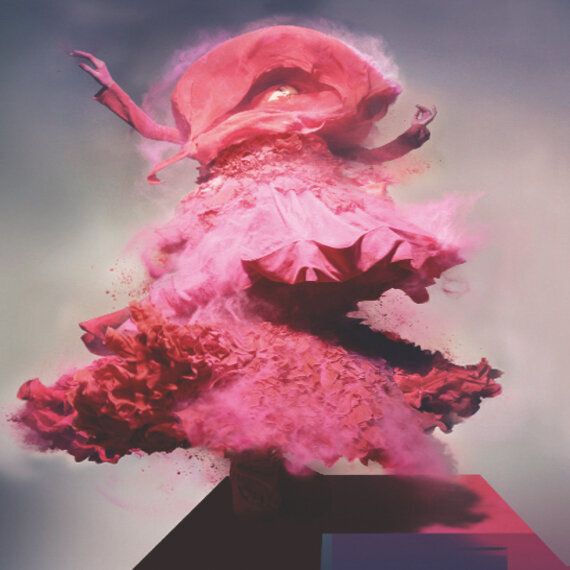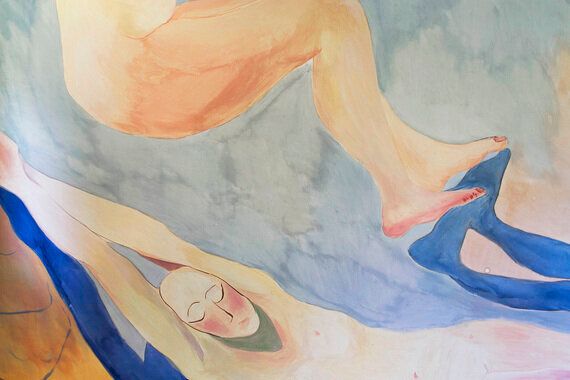Art is a therapeutic medium, just like music. It, too, is a vehicle in which we can do such things as recover hope, dignify suffering, develop empathy, laugh, wonder, nurture a sense of communion with others, and regain a sense of justice and political idealism. Alain de Botton, Art as Therapy. The Hospital Rooms
We know how lucky we are to have the NHS and it's services, spanning physical and mental health care. Sometimes though, we leave with our bodies healed, and our spirits a little diminished. If you have spent time visiting a loved one in a mental health unit, a situation that curator Niamh White and artist Tim A Shaw found themselves in, you may come away thinking that the environment of these units could do with some care.
Our surroundings affect experience and perception of ourselves, more so for those in a vulnerable situation. With this in mind, Niamh and Tim approached The Arts Council with a proposal to commission contemporary artists to refurbish mental health wards in the NHS. Six weeks later the Hospital Rooms was born. A project which aims to support patients and visitors to mental health units in the UK. Joining forces with South West London and St George's Mental Health NHS Trust, they have commissioned artists including Nick Knight OBE and Gavin Turk to refurbish the Phoenix Unit at Springfield University Hospital in Tooting.

Nick Knight's 'Lily' in The Phoenix Unit, Springfield Hospital London. Photo © The Hospital Rooms
The need for supporting mental health units in the UK cannot be underestimated. Mental health problems constitute the largest single source of world economic burden, with an estimated global cost of £1.6 trillion; greater than cardiovascular disease, chronic respiratory disease, cancer and diabetes on their own. And yet, mental illness is still a taboo in this country meaning that 75% of sufferers keep silent about their illness.
LM Why do you think that the look of NHS spaces are overlooked?
THR NHS budgets are always stretched, and improving the environmental conditions of hospitals is never the top priority. Understandably, money is going towards staff, prescribed drugs and social care. However, having the right environment to recover in and having a stimulating living space for someone in rehabilitation is vitally important. We hope that projects like ours will help to demonstrate how valuable imaginative and thought-provoking art and design is.
LM The Phoenix Unit at Springfield University Hospital in Tooting was your debut project. How did this come about?
THR It was important that we worked with a trust that was forward thinking. We approached Dr. Emma Whicher, the Medical Director at Springfield about undertaking a project at the hospital, and she was enthusiastic. She recommended that we take on Phoenix Unit, a secure residential rehabilitation unit for people with a diagnosis of schizophrenia, and set up a meeting with Dr. Charlotte Harrison, the consultant psychiatrist who has a particular interest in multi-sensory therapy.
LM Can you describe your first impression of Springfield prior to refurbishment?
THR The unit is bright with lots of natural light, and there are several communal spaces for service users to watch TV, rest and participate in activities. Although there is a Quiet Room, Activity Room and Women's Lounge, there was little that differentiated one from the next.

Aimee Parrot's work in the Women's Room of the Phoenix Unit, Springfield Hospital London. Photo © The Hospital Rooms
LM I imagine that patient input was paramount?
THR We visited the unit 16 times before starting work onsite. Each time we would speak to service users and staff, and bring along one of the artists, as these visits informed the work. In one of our first meetings it became apparent that the courtyard area is an important part of the unit, especially for those users who aren't able to have non-escorted leave. We hadn't originally planned on undertaking any work on the outdoor space, but as a result of these meetings we commissioned the landscape architect, Joh Bates, to tackle the courtyard. My work was informed by requests for service users to display their own works. I made the Dining Room into the 'Phoenix Gallery', a space for the users to display their own work made during our workshops, in turn encouraging their creative practice.
LM Can you talk about the process from conception to completion?
THR Once the artists had visited the unit, spoken to staff, service users and chosen the room that they wanted to work on, they would give us a detailed description of what they had planned. We would then propose the ideas to the consultant psychiatrist, the occupational therapists, maintenance and health and safety to get feedback on the suitability of subject matter and compliance. We discussed in detail the physical restrictions of the unit, and made sure that all artworks were compliant, safe and robust, then submitted proposals to the trust. We were very aware that we were going to be spending a large amount of time in the users' home. We were generously welcomed, and had fascinating conversations about the work.
LM There are prestigious artists involved. How did their experience of the NHS influence their contributions?
THR Our artists have various experiences of mental health services and approached the spaces with this in mind. Also, the artists' expertise in making work that lasts and is of the highest quality was invaluable.
LM Niamh, how has the Hospital Rooms influenced your work as a curator?
THR Working on this project has been unlike any other. The project is curatorially rigorous. We focus on actively co-producing projects with artists, mental health service users and mental health practitioners to capitalise on different streams of knowledge and create solutions to social needs.
LM What is your vision for developing the Hospital Rooms in the future?
THR We have completed the installations at Phoenix unit, and are currently mid way through our workshops with the service users. We are now a registered charity and are currently in the final stages of planning another large project, and have several more in the pipeline.